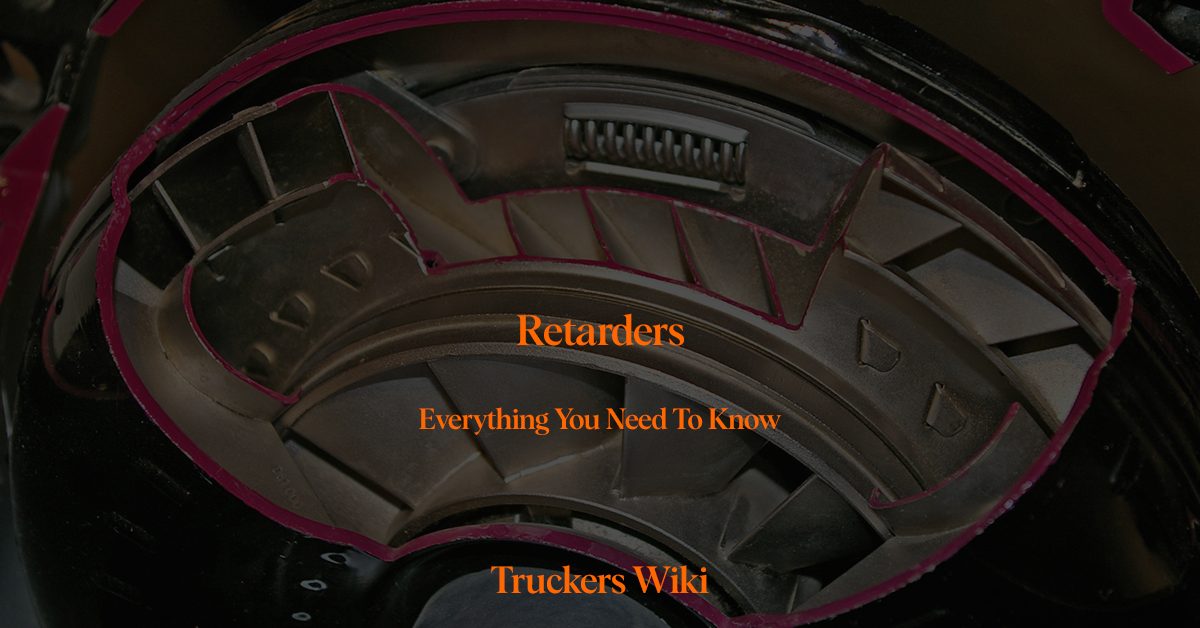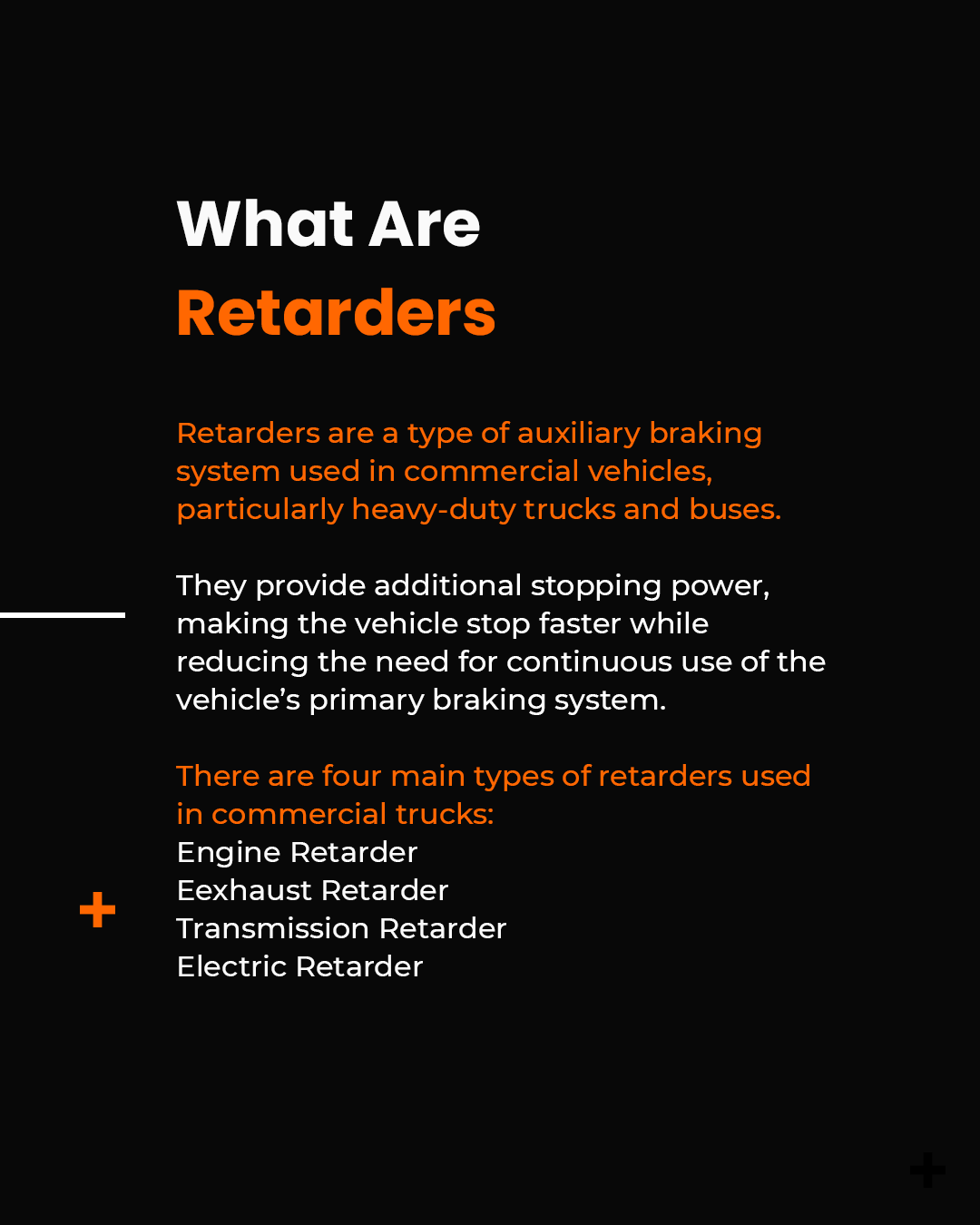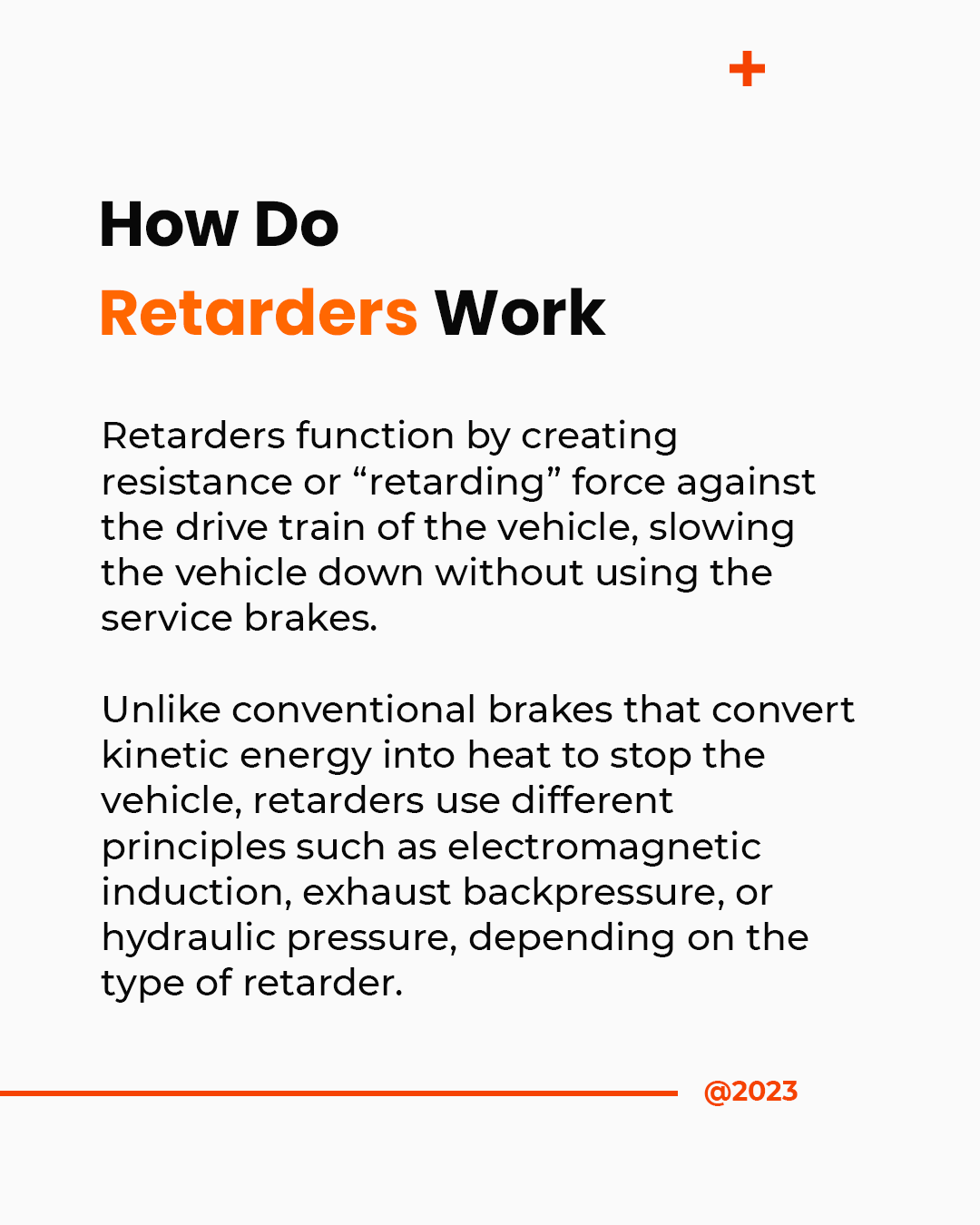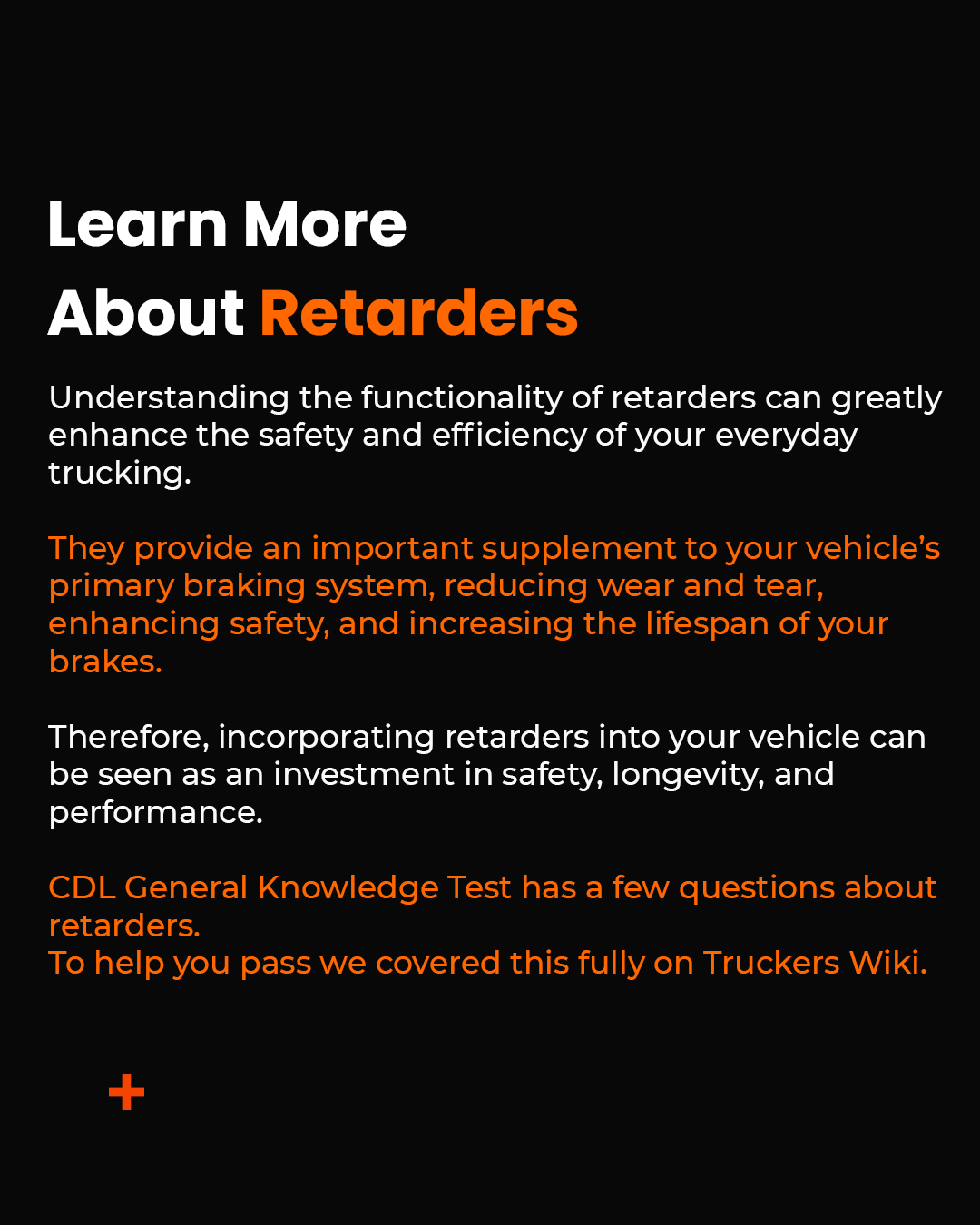
Table of Contents
What are Retarders CDL – Truck Retarders?
Retarders, referred by some as retarders CDL are a type of auxiliary braking system used in commercial vehicles, particularly heavy-duty trucks and buses. They provide additional stopping power, making the vehicle stop faster while reducing the need for continuous use of the vehicle’s primary braking system. The key role of retarders is to control speed, particularly when the vehicle is going downhill for prolonged periods. By doing so, they help prevent overheating and subsequent brake fade in the conventional braking system, contributing to increased safety and brake lifespan. Now that we know what are truck retarders, let’s take a look at how they work. Additional point to note is the fact that retarders have nothing to do with CDL, but with commercial motor vehicles (CMV).
How do Retarders Work?
Retarders function by creating resistance or “retarding” force against the drive train of the vehicle, slowing the vehicle down without using the service brakes. Unlike conventional brakes that convert kinetic energy into heat to stop the vehicle, retarders use different principles such as electromagnetic induction, exhaust backpressure, or hydraulic pressure, depending on the type of retarder.
Heads up:
Note that applying retarders on bad tires or slippery roads can cause your vehicle to skid. It should be turned off when driving on wet, icy, or roads that are covered with snow.
You should also note that using CDL retarders is restricted in some areas due to their loud noise, excluding electric retarders that are silent.
Types of Truck Retarders
There are four main types of retarders used in commercial trucks: engine retarders, exhaust retarders, transmission retarders and electric retarder.
Engine Retarders (Jake Brake)
Also known as Jake brakes, engine retarders are designed to change the engine’s valve timing. When activated, they open the exhaust valve right after the compression stroke, releasing the compressed air before it can push the piston down, thereby slowing the vehicle down. Jake brakes are effective but can be quite noisy, leading to their restriction in some residential areas. Here are the pros and cons of jake brake.
Pros of Engine Retarders
Extended Brake Life: One of the primary advantages of using jake brake retarders is that they reduce the wear and tear on the conventional friction brakes. By distributing the braking force between the engine and the service brakes, jake brakes can significantly extend the lifespan of the brake components.
Improved Safety: Jake brake retarders can enhance safety by providing additional braking power, especially when driving downhill or on slippery surfaces. This helps prevent overheating of the service brakes and reduces the risk of brake fade.
Reduced Brake Fade: Continuous use of the service brakes, especially during downhill descents, can cause brake fade due to heat buildup. Jake brakes help minimize this heat buildup and reduce the likelihood of brake fade, maintaining consistent braking performance.
Enhanced Engine Control: Jake brakes contribute to better control over the vehicle’s speed, allowing for smoother and safer driving in challenging conditions. They help prevent the truck from gaining excessive speed, particularly when traveling downhill.
Fuel Efficiency: When used strategically, jake brakes can save fuel by using the engine’s compression to slow down the vehicle instead of dissipating energy through the service brakes. This can be particularly beneficial for long-haul trucks.
Cons of Engine Retarders
Noise: One of the most significant drawbacks of jake brake retarders is the loud noise they produce. The release of compressed air creates a distinct “braking” sound that can be disruptive to nearby residents, especially in urban areas or quiet neighborhoods.
Vibration: Jake brakes can cause vibrations in the truck’s drivetrain and chassis, leading to increased wear on components and a less comfortable ride for the driver.
Limited Effectiveness at Low Speeds: Jake brakes are most effective at higher speeds, and their effectiveness decreases at lower speeds. This means that they may not provide sufficient braking power in certain situations, such as when navigating through slow-moving traffic or making tight maneuvers.
Maintenance and Reliability: Like any mechanical device, jake brake retarders require maintenance and can experience malfunctions. Ensuring their proper function requires regular inspections and potential repairs.
Legal Restrictions: In some regions, the use of jake brakes is restricted or prohibited due to noise concerns, especially in residential areas. This can limit their utility and require drivers to rely more on conventional service brakes.
Here is a great video explanation of how jake brakes works by JacobsVehicleSystems.
Exhaust Retarders
Also known as exhaust brakes are a type of braking system commonly used in semi trucks to assist in slowing down the vehicle. Unlike compression-release engine brakes (jake brakes), which use the engine’s compression to slow down the vehicle, exhaust retarders restrict the flow of exhaust gases to create back pressure, which aids in deceleration. They are quieter than Jake brakes but also less powerful.
Pros of Exhaust Retarders
Effective on Downhill Grades: Exhaust retarders are particularly effective on downhill grades. They can help control speed and provide additional braking force, reducing the need to rely solely on the service brakes, which can overheat on long descents.
Extended Brake Life: By using the engine’s exhaust system to aid in slowing down the vehicle, exhaust retarders can reduce wear and tear on the conventional friction brakes. This can extend the lifespan of the braking components.
Improved Control: Exhaust retarders provide gradual and controlled deceleration, allowing the driver to maintain better control of the vehicle’s speed, especially on slippery surfaces or challenging road conditions.
Quiet Operation: Exhaust retarders generally produce less noise compared to compression release engine brakes. This can be beneficial when driving through noise-sensitive areas.
Less Vibration: Exhaust retarders produce less vibration compared to compression release engine brakes, resulting in a smoother and more comfortable driving experience for the operator.
Cons of Exhaust Retarders
Limited Effectiveness at High Speeds: Exhaust retarders may have limited effectiveness at high speeds. As the vehicle’s speed increases, the back pressure generated by the exhaust retarder may become less effective in slowing down the truck.
Reduced Engine Performance: The use of exhaust retarders can affect the engine’s performance by restricting the flow of exhaust gases. This could lead to reduced power output and acceleration, particularly on uphill climbs.
Heat Generation: Exhaust retarders generate heat within the exhaust system. Continuous use, especially on long descents, can result in increased temperatures in the exhaust components, which could potentially lead to overheating and component wear.
Maintenance Complexity: Exhaust retarders are integrated into the engine and exhaust system, which can add complexity to maintenance and repair procedures. Addressing issues or performing maintenance might require specialized knowledge.
Vehicle Compatibility: Not all truck engines are compatible with exhaust retarders. Some engines may not have the necessary components to support the system, limiting its availability as an option.
Initial Cost: The installation of exhaust retarders can involve higher upfront costs, including both the equipment itself and any necessary modifications to the exhaust system.
Transmission Retarders
Also known as transmission brakes or driveline retarders use hydraulic principles to slow the vehicle. When activated, they circulate transmission fluid against a stator, creating resistance that slows the vehicle’s driveshaft. This however won’t fully stop the vehicle, so it should only be used as a suplementary braking force as the transmission retarder becomes less impactful the slower the vehicle is moving. It also has a lag time (delay) before the slowing force is applied. They are smooth, quiet, and powerful, but they also require significant maintenance.
Pros of Exhaust Retarders
Enhanced Brake Life: Similar to jake brake retarders, transmission retarders help reduce wear and tear on the conventional friction brakes. By distributing the braking force between the transmission and the service brakes, transmission retarders can extend the lifespan of the braking components.
Noise Reduction: Compared to jake brake retarders, transmission retarders tend to produce less noise. The braking action is typically quieter, making them more suitable for noise-sensitive areas.
Smooth Deceleration: Transmission retarders offer a smoother deceleration experience compared to jake brake retarders. The braking force is distributed through the entire driveline, leading to a more controlled slowdown.
Constant Braking Force: Transmission retarders provide consistent braking force across a range of speeds. This makes them effective at various speeds, including low speeds, where jake brakes may have limited effectiveness.
Less Vibration: Transmission retarders generally produce less vibration compared to jake brake retarders. This results in a smoother ride for the driver and less wear and tear on the vehicle’s components.
Cons of Exhaust Retarders
Limited Effectiveness on Steep Descents: While transmission retarders can provide effective deceleration on moderate grades, they may struggle to maintain speed on steeper descents compared to jake brake retarders. This could require more frequent use of the service brakes on steep downhill stretches.
Less Aggressive Braking: In some situations, particularly when needing rapid deceleration, transmission retarders may not provide the same aggressive braking power as jake brake retarders. This could impact safety in emergency braking scenarios.
Potential Overheating: Continuous use of transmission retarders on long downhill descents can generate heat within the transmission. This heat buildup could potentially lead to transmission overheating and affect its performance.
Maintenance Complexity: Transmission retarders are integrated into the driveline, which can add complexity to maintenance and repair procedures. If issues arise, addressing them may require specialized knowledge.
Initial Cost: The installation of transmission retarders can involve higher upfront costs compared to jake brake retarders. However, these costs could potentially be offset by extended brake life and improved overall vehicle performance.
Transportation Heavy Equipment Tech YouTube channel has an amazing video about hydraulic retarders, here is the link, make sure to check it out!
Electric Retarders
The system is designed to assist in slowing down a vehicle by converting its kinetic energy into electrical energy, which can be stored and reused or dissipated as heat. They operate on the principles of electromagnetic induction. Essentially, it consists of two key parts: a stator (an electromagnetic coil) and a rotor (a metal disc) which is connected to the vehicle’s driveshaft.
Electric retarders are particularly effective on downhill grades, where the vehicle’s kinetic energy can be harnessed to generate electrical energy.
Pros Electric Retarders
Energy Recovery: One of the main advantages of electric retarders is their ability to recover and reuse energy that would otherwise be lost as heat during braking. This energy is converted into electricity and can be stored in batteries or used to power other vehicle systems.
Reduced Brake Wear: By relying more on regenerative braking provided by electric retarders, the wear and tear on conventional friction brakes are reduced. This can extend the lifespan of the braking components and decrease maintenance costs.
Enhanced Control: Electric retarders can provide precise control over deceleration. The system can be adjusted to provide varying levels of braking force, making it easier for drivers to manage speed on downhill grades or in traffic.
Quieter Operation: Electric retarders are generally quieter compared to traditional engine braking systems. This can be beneficial when driving through noise-sensitive areas, and it also contributes to a quieter overall driving experience.
Smooth Braking: The application of electric retarders can result in smoother braking compared to traditional friction brakes, offering a more comfortable experience for both the driver and any cargo being transported.
Cons Electric Retarders
Limited Effectiveness at Low Speeds: Electric retarders may have limited effectiveness at very low speeds, such as during parking or maneuvering. At extremely low speeds, the regenerative braking system might not provide enough deceleration force.
Dependency on Battery Capacity: Electric retarders rely on the vehicle’s battery capacity to store the generated electrical energy. If the batteries are not adequately charged or have limited capacity, the effectiveness of the system can be compromised.
Initial Cost: The installation of electric retarders can involve higher upfront costs due to the need for specialized components, including electric motors and energy storage systems.
Complexity: Electric retarders add complexity to the vehicle’s systems, requiring integration with the electrical and electronic architecture of the truck. This complexity can increase maintenance and repair challenges.
Weight: The addition of electric retarders and associated components can add weight to the vehicle, potentially impacting fuel efficiency and payload capacity.
Dependence on Infrastructure: The effectiveness of electric retarders depends on the availability of a suitable infrastructure for energy storage and management, including charging and energy recovery systems.
Understanding their functionality can greatly enhance the safety and efficiency of your everyday trucking. They provide an important supplement to your vehicle’s primary braking system, reducing wear and tear, enhancing safety, and increasing the lifespan of your brakes. Therefore, incorporating retarders into your vehicle can be seen as an investment in safety, longevity, and performance.
Remember, it is always crucial to maintain and inspect all braking systems regularly to ensure their optimal performance. Always consult with a professional or your vehicle’s manufacturer for advice specific to your vehicle’s braking systems. Safe driving to you all!
Here is a YouTube video on how retarders work.
This article should provide a good base for understanding retarders in the context of commercial trucking. Note that the details of these systems can vary between different models and manufacturers, so it’s important to be familiar with the specifics of the vehicles and retarder you’re working with.
Click here to learn everything you need to know about CDL endorsements.
Learn about CDL Restrictions here.
Intrastate vs. interstate trucking, what is the difference?
External Links
Video by Smart Trucking about Jake Brake.
eDrive Manuals of CDL retarders.
Man Truck and Buses Retarders glossary.
Learn about Conestoga trailer here.
Listen to The Article Here
Hydraulic Retarder Explanation by Transportation Heavy Equipment
Fact Cards





Audio Article Retarders Retarders CDL Truck Retarders What are
Last modified: March 14, 2024

